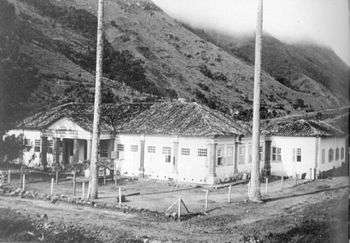Fazenda
A fazenda is a plantation found throughout Brazil; during the colonial period (16th - 18th centuries). They were concentrated primarily in the northeastern region, where (sugar) was produced, expanding during the 19th century in the southeastern region to coffee production. Fazenda now denotes any kind of farm.

Fazendas created major export commodities for Brazilian trade, but also led to intensification of slavery in Brazil. Coffee provided a new basis for agricultural expansion in southern Brazil. In the provinces of Rio de Janeiro and then São Paulo, coffee estates, or fazendas, began to spread toward the interior as new lands were opened.[1] By 1850, coffee made up more than 50% of Brazil's exports, and more than half of world coffee production.[2]
Along with the expansion of coffee growing came an intensification of slavery in Brazil, as the country's primary form of labor. More than 1.4 million Africans were forced to be slaves in Brazil in the last 50 years of the slave trade, and even after the trans-Atlantic slave trade ended, slavery continued until 1888.[3]
Because of the increased profit from the trade of coffee, the years after 1850 saw considerable growth and prosperity in Brazil. Railroads, steamships and the telegraph were introduced to Brazil, all paid for by the money the fazendas supplied from their coffee crop. In growing cities such as Rio de Janeiro and São Paulo, merchants, lawyers, a middle class, and an urban working class grew, once again paid for by the money coming from the fazendas.
Modern forced labour practices
More than 100 years after the end of slavery, forced labour practices in Brazil still occur in both rural and urban areas, mainly through debt bondage schemes. In rural areas, workers are detained on farms until they pay their debts, which are often fraudulently incurred. Their identity documents and work permits are often seized by the employer. They are often under surveillance of armed guards. Those who protest are physically threatened; if they try to escape, they may be killed.[4]
See also
References
- Chambers, William; Robert Chambers (1879-12-27). "Slave-life in Brazil". Chambers's journal of popular literature, science, and art. 56. London: W. & R. Chambers. pp. 823–824.
- Baronov, David (2000). The abolition of slavery in Brazil: the "liberation" of Africans through the emancipation of capital. Greenwood Publishing Group. p. 183. ISBN 978-0-313-31242-7.
- The Abolition of slavery and the aftermath of emancipation in Brazil. Rebecca Jarvis Scott (ed.). Duke University Press. 1988-09-01. ISBN 978-0-8223-0888-1.CS1 maint: others (link)
- Combating Forced Labour in Brazil. International Labour Organization (ILO).